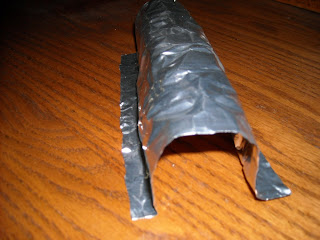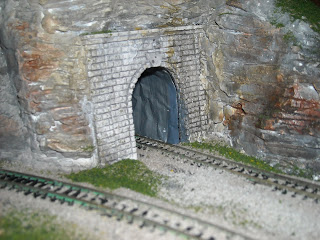
Geof has very kindly agreed to share this idea for tunnel construction with readers:
Picture #1: This is a shot of the materials you’ll need for this project. The stapler OR the glue can be used to attach the liner to the layout table. I prefer the stapler myself but if the tunnel is already in place, you may have to use the glue instead.
I have come up with a quick and easy method of construction that yields a great visual result for any scale with less effort. The technique I am going to describe is best when used on tunnels currently under construction although it can be used on existing tunnels but it is a little difficult to install.
To start, go to your local grocery or household discount store and purchase some heavy duty disposable cookie trays or sheet pans (aluminum foil in the roll form is too flimsy). A sheet pan that is 12″ x 18″ should yield about six linings in HO scale, 8 or more in N Scale and at least two in O gauge.
Next, get the INSIDE measurement of the portal and its sides. I use a flexible measuring tape for doing this. A single track N scale portal arch is about five inches, other scales or portal types would be longer. Whatever this measurement is add at LEAST another inch. This extra amount will act as ‘feet’ to mount the lining.
Using using a pair of utility scissors, cut the foil into strips as wide as the measurement you got from the step above. The lining length (or depth) is up to you. Seven inches is a good length for N scale. If the portal is on a high location on your layout where people can look down it, you may want to extend this for better effect.
Next, gently crumple the foil to give the illusion of blasted rock. The tighter you crumple it, the more creases will form so, again, it is up to you how much of this you want. Avoid crumpling the foil too much because it may be difficult to straighten it out for the next step.
Once you are happy with the crumple effect, flatten the foil out and then curl it into an arch that roughly matches the shape of the portal. Next, fold the outside edges of the lining (about 1/2 inch worth) outward to make ‘feet’ that run the length of the lining on both sides. When looked at from the front, it should look like the Greek letter omega ( like this -> Ω ). These feet are used to attach the foil lining to the layout’s surface so it won’t shift about.




This is a great idea. Maqny thanks for sharing it. Also check out Robert’s mountain building ideas. They really helped me.